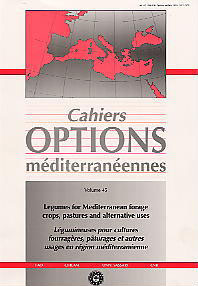| Article précédent | p. 99-102 | Article suivant |
Globe locust (Robinia pseudoacacia var. umbraculifera D.C.): a potential forage species?
Globe locust (Robinia pseudoacacia var. umbraculifera D.C.), a small leguminous tree, is one of the several botanical varieties of black locust (Robinia pseudoacacia L.). It has a dense, globe-shaped crown, and it is often used - grafted on a black locust rootstock - for ornamental purposes. It is thornless and rarely flowers. This variety was studied in terms of forage production and quality along with clones and half-sib families of the black locust variety monophylla and common black locust as a control, in the farm of the Forest Research Institute, NE of Thessaloniki, in Greece . More specifically, ramets of globe locust produced by rooted stem cuttings were tested for three consecutive years (1994-96) and at the end of each growing period the height, the above ground biomass and crude protein (CP) content of leaves were measured.
- [ Afficher ]
- [ Télécharger ]
- [ Exporter la citation ]
Vous pouvez télécharger la citation au format :
- [ Imprimer ]
-
Mots-clés
BIOMASSE, HAUTEUR, PATURAGES, ROBINIA PSEUDOACACIA, ZONE MEDITERRANEENNECiter cet article
Dini-Papanastasi O. Globe locust (Robinia pseudoacacia var. umbraculifera D.C.): a potential forage species?. In : Sulas L. (ed.). Legumes for Mediterranean forage crops, pastures and alternative uses . Zaragoza : CIHEAM, 2000. p. 99-102. (Cahiers Options Méditerranéennes; n. 45). 10. Meeting of the Mediterranean Sub-Network of the FAO-CIHEAM Inter-Regional Cooperative Research and Development Network on Pastures and Fodder Crops, 2000/04/04-09, Sassari (Italy). http://om.ciheam.org/om/pdf/c45/00600177.pdf



